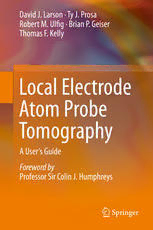
Local Electrode Atom Probe Tomography: A User's Guide PDF
Preview Local Electrode Atom Probe Tomography: A User's Guide
David J. Larson · Ty J. Prosa Robert M. Ulfi g · Brian P. Geiser Thomas F. Kelly Local Electrode Atom Probe Tomography A User‘s Guide Foreword by Professor Sir Colin J. Humphreys Local Electrode Atom Probe Tomography David J. Larson (cid:129) Ty J. Prosa (cid:129) Robert M. Ulfig Brian P. Geiser (cid:129) Thomas F. Kelly Local Electrode Atom Probe Tomography A User’s Guide Foreword by Professor Sir Colin J. Humphreys, CBE, FRS, FREng. DavidJ.Larson TyJ.Prosa CAMECAInstruments,Inc. CAMECAInstruments,Inc. Madison,WI,USA Madison,WI,USA RobertM.Ulfig BrianP.Geiser CAMECAInstruments,Inc. CAMECAInstruments,Inc. Madison,WI,USA Madison,WI,USA ThomasF.Kelly CAMECAInstruments,Inc. Madison,WI,USA ISBN978-1-4614-8720-3 ISBN978-1-4614-8721-0(eBook) DOI10.1007/978-1-4614-8721-0 SpringerNewYorkHeidelbergDordrechtLondon LibraryofCongressControlNumber:2013953879 ©SpringerScience+BusinessMediaNewYork2013 Thisworkissubjecttocopyright.AllrightsarereservedbythePublisher,whetherthewholeorpart of the material is concerned, specifically the rights of translation, reprinting, reuse of illustrations, recitation,broadcasting,reproductiononmicrofilmsorinanyotherphysicalway,andtransmissionor informationstorageandretrieval,electronicadaptation,computersoftware,orbysimilarordissimilar methodologynowknownorhereafterdeveloped.Exemptedfromthislegalreservationarebriefexcerpts inconnectionwithreviewsorscholarlyanalysisormaterialsuppliedspecificallyforthepurposeofbeing enteredandexecutedonacomputersystem,forexclusiveusebythepurchaserofthework.Duplication ofthispublicationorpartsthereofispermittedonlyundertheprovisionsoftheCopyrightLawofthe Publisher’s location, in its current version, and permission for use must always be obtained from Springer.PermissionsforusemaybeobtainedthroughRightsLinkattheCopyrightClearanceCenter. ViolationsareliabletoprosecutionundertherespectiveCopyrightLaw. The use of general descriptive names, registered names, trademarks, service marks, etc. in this publicationdoesnotimply,evenintheabsenceofaspecificstatement,thatsuchnamesareexempt fromtherelevantprotectivelawsandregulationsandthereforefreeforgeneraluse. While the advice and information in this book are believed to be true and accurate at the date of publication,neithertheauthorsnortheeditorsnorthepublishercanacceptanylegalresponsibilityfor anyerrorsoromissionsthatmaybemade.Thepublishermakesnowarranty,expressorimplied,with respecttothematerialcontainedherein. Printedonacid-freepaper SpringerispartofSpringerScience+BusinessMedia(www.springer.com) Preface Overtheyearsanumberofatomprobebookshavebeenwrittenbyvariousauthors [1–10],sowhywriteanotheroneyoumightask.Webelievethatthisbookisunique in specifically targeting atom probe adopters who are new to the technique. The bookintroducesnewuserstotheprocessofperformingalloftheaspectsofaLocal Electrode Atom Probe™ experiment. It includes the fundamentals of preparing specimensforthemicroscopefromavarietyofmaterials,detailsoftheinstrumen- tation used in data collection, parameters under which optimal data are collected, current methods of data reconstruction, and selected methods of data analysis. In addition, certain topics are explained specifically from a user perspective and include details that are often learned only through trial and error, allowing users tosucceedmorequicklyinthechallengingareasofspecimenpreparationanddata collection. Thisbookismeanttobeausefulreferenceforthe“conventionalwisdom”type of information that is not always found in academic books and is usually gained onlythroughexperience.Itisnotmeanttobeacomprehensive treatmentofatom probetomographybutratheraneverydayreferencefordatacollectiononthelocal electrode atom probe and for the specimen preparation and data analysis that go alongwithsuchexperiments.Forthemostpart,wehavedealtwithmoreadvanced topics,such asthedetailsofthespatialreconstructionequations,byincludingthe information in appendices or by simply referring the reader to other textbooks or journalarticles.Inthiswaywehopetohaveproducedaveryusablereferencefor bothnoviceusersandexperiencedscientists.Thefutureofatomprobetomography isbright,andwehopethatthepathtoadoptionwillbeclearerwiththeavailability ofthisbook. Madison,WI,USA DavidJ.Larson TyJ.Prosa RobertM.Ulfig BrianP.Geiser ThomasF.Kelly v vi Preface References 1. Mu¨ller, E.W., Tsong, T.T.: Field Ion Microscopy Principles and Applications. Elsevier, NewYork(1969) 2. Hren,J.J.,Ranganathan,S.(eds.):Field-IonMicroscopy.PlenumPress,NewYork(1968) 3. Bowkett,K.M.,Smith,D.A.:Field-IonMicroscopy.North-Holland,Amsterdam(1970) 4. Muller,E.W.,Tsong,T.T.:FieldIonMicroscopy,FieldIonizationandFieldEvaporation,vol. 4.ProgressinSurfaceScience(1973) 5. Miller, M.K., Smith, G.D.W.: Atom Probe Microanalysis: Principles and Applications to MaterialsProblems.MaterialsResearchSociety,Pittsburgh(1989) 6. Sakurai,T.,Sakai,A.,Pickering,H.W.:Atomprobefieldionmicroscopyanditsapplications. Adv.Electron.Electron.Phys.20,1–299(1989) 7. Tsong, T.T.: Atom-Probe Field Ion Microscopy: Field Ion Emission and Surfaces and Interfaces at Atomic Resolution. Cambridge University Press, Cambridge, Great Britain (1990) 8. Miller,M.K.,Cerezo,A.,Hetherington,M.G.,Smith,G.D.W.:AtomProbeFieldIonMicros- copy.OxfordUniversityPress,Oxford(1996) 9. Miller,M.K.:AtomProbeTomography:AnalysisattheAtomicLevel.KluwerAcademic/ PlenumPublishers,NewYork(2000) 10. Gault,B.,Moody,M.P.,Cairney,J.M.,Ringer,S.P.:AtomProbeMicroscopy.SpringerSeries inMaterialsScience,vol.160.Springer(2012) Acknowledgment 1 NumerouspeoplehavecontributedtothedevelopmentandsuccessoftheLEAP overtheyears.Wewouldcertainlyliketoincludeeveryonewhoparticipatedinthis venture,butwearecertaintomissafewnames,andsoweapologizeinadvancefor anyomissions. We would like to start with a special acknowledgement to the family of Tom Kelly—withouttheirencouragementandsupportovertheyears,thecurrentLEAP would not exist. We would like to acknowledge all of the past employees of CAMECA1 (formerly Imago™ Scientific Instruments) who played critical roles inthedevelopmentoftheLEAP;mostnotablywewouldliketothankDr.TyeT. Gribb for all of his contributions toward making the LEAP what it is today. We would also like to thank all of the current employees of CAMECA with a special acknowledgmenttotheengineeringteamforcreatingamarvelousinstrument:Joe Bunton,DanLenz,JesseOlson,EdOltman,TimPayne,DanRauls,JeffShepard, EricStrennen,MarkLamers,andDaveSund. We would especially like to thank our colleagues who have assisted in the preparationofthisbookbyreviewingindividualchapters.Professionalcolleagues include Frederic Danoix, Baptiste Gault, Stephan Gerstl, Michael Miller, Sergej Mutas, John Panitz, Danny Perea, Amanda Petford-Long, Krishna Rajan, C.J. Humphreys,andDanSchreiber.WewillparticularlyliketothankRichardForbes forassistancewithoneoftheappendices.Likewise,ourCAMECAcolleagueswho have reviewed chapters include Peter Clifton, Devin Giddings, Daniel Lawrence, DanLenz,MarkLevesque,DavidOlson,JesseOlson,EdOltman,DavidReinhard, HuguesFrancoisSaintCyr,MichelSchumacher,EricStrennen,SavannaStrennen, LudovicRenaud,andJohnWatson. We would also like to thank the scientists and publishers who have granted us permission to include portions of their work in this book: D. Abou-Ras, H.O.Andre´n,O.H.Auciello,P.A.J.Bagot, J.Ballard,R. Banerjee,G.Brennecka, R. Caballero, J. Cairney, A.J. Cavosie, A. Cerezo, V. Chitry, P.P. Choi, O. Cojocaru-Mire´din, X.Y. Cui, T.L. Daulton, A.M. Davis, F. DeGeuser, S.P. DenBaars, A. Deschamps, D.R. Diercks, D.M. Dimiduk, J.W. Elam, P. Felfer, C. Floss, H.L. Fraser, B. Gault, M. Gilbert, H. Gnaser, L.M. Gordon, vii viii Acknowledgment B.P. Gorman, T.T. Gribb, G.H. Gu, E.E. Haller, M. Hasegawa, P.R. Heck, M.A. Hekmaty, A. Henjered, K. Henry, J. Hiller, A.C. Hillier, C. Hombourger, Y.L. Hu, J.Y. Hwang, K. Inoue, D. Isheim, K.M. Itoh, D. Jager, M.J. Jercinovic, D.Joester,A.K.Kambham,Y.Kawamura,K.F.Kelton,M.Kimoto,R.Kirchhofer, S. Koelling, N. Kruse, L.J. Lauhon, W. Lefebvre, J.L. Lensch, J. Lewis, T. Li, P. Liddicoat, L. Longstreth-Spoor, A. Mane, E.A. Marquis, I. Martin, S.J. May, B. Mazumder, A.J. Melmed, T.P. Melo, M.K. Miller, J. Mody, M.P. Moody, D. Moser, C.K.S. Moy, E.W. Mu¨ller, Y. Nagai, S. Nakamura, A. Nishida, O. Nishikawa, H. Norde´n, J.A. Panitz, C.G. Park, M.J. Pellin, D.E. Perea, T.C. Petersen, D. Raabe, J.N. Randall, G. Ranzi, R.F. Reidy, L. Renaud, S.P. Ringer, M. Romanes, M.R. Savina, D.W. Saxey, D. Schreiber, D.N. Seidman, Y. Shimizu, R. Shivaraman, C. Sigli, V.S. Smentkowski, G.D.W. Smith, D. Snoeyenbos, J.S. Speck, R. Srinivasan, F.J. Stadermann, E. Steel, T. Stephan, A. Strickland, G. Sundell, H. Takamizawa, M.C. Teague, M. Thuvander, J. Tiley, T. Toyama, S.C.E. Tsang, T. Tsunomura, A. Tyagi, M. Uematsu, T. Ushikubo, J.W. Valley, W. Vandervorst, F. Vurpillot, G.B. Viswanathan, B.W. Wessels, S. Wilde, C.A. Williams, M.H. Wong, R. Wuerz, Y. Xiang, F. Yano, Y. Zhang, and H. Zhong. We also thank the companieswhogranteduspermissiontodisplayimages,graphs,orschematicsor whoaidedinsomeimplementationofLEAPanalysis,includingEvansAnalytical 1 Group , Dune Sciences, Gatan, Fischione, Omniprobe, Hummingbird Scientific, andXEIScientificInc. Foreword Atom probe tomography has had explosivegrowthinrecent years. Thetechnique wasbornwaybackin1935whenEdwinMu¨llerinventedthefieldemissionelectron microscope.Thisoriginalatomprobeinstrumentwasdifficulttouseandcouldonly beappliedtometals.Modern-dayatomprobetomographyisstraightforwardtouse and can be applied not only to metals but also to semiconductors, ceramics, geologicalmaterials,organicmaterials,biologicalmaterials,andcomposites. This is a wonderful book which should be in every science library and on the bookshelves of scientists and engineers interestedin the characterization ofmate- rials at the atomic level. The book requires no prior knowledge of atom probe tomographyandtakesreadersthroughfromthehistoryofthelocalelectrodeatom probe tothe latest developments inthe field. Although atom probe tomography is nowaneasytechniquetouse,theinterpretationoftheresultsrequiresconsiderable care and understanding. This book takes readers step by step through data collec- tion, data reconstruction, and data analysis. As with all microscopies, good speci- men preparation is the key to obtaining world-class results. Various methods of specimen preparation are described in detail, together with clear instructions on how to optimize specimen preparation using, for example, focused ion beam methods. Itisagreatpleasureformetorecommendthiscomprehensiveyetveryreadable bookonthelocalelectrodeatomprobe,whichcomplementsothermethods,suchas atomicresolutionelectronmicroscopy.Ibelievethatatomprobetomographywill increasinglybeusedbyscientistsandengineersinvolvedwiththecharacterization ofmaterialsanddevicesattheatomiclevel.Ihavenodoubtthatthisexcellentbook willbewidelyusedbytheatomprobecommunity. ProfessorSirColinJ.Humphreys ProfessorofMaterialsScienceandDirectorofResearch UniversityofCambridge ix
